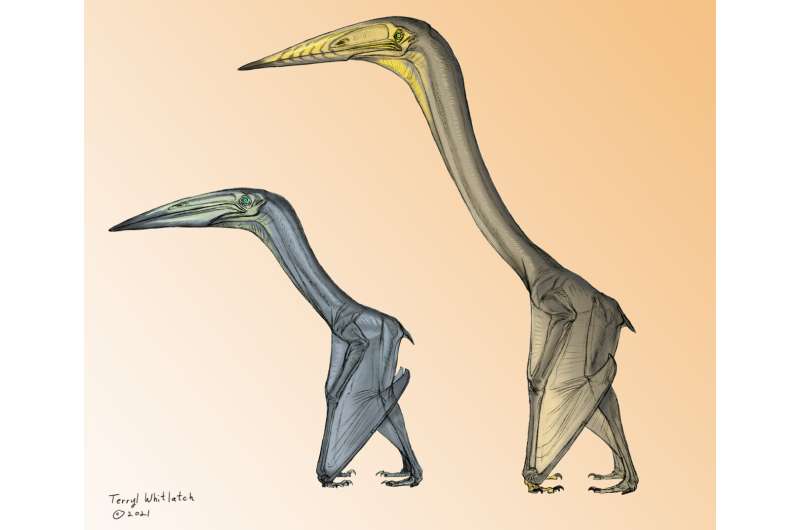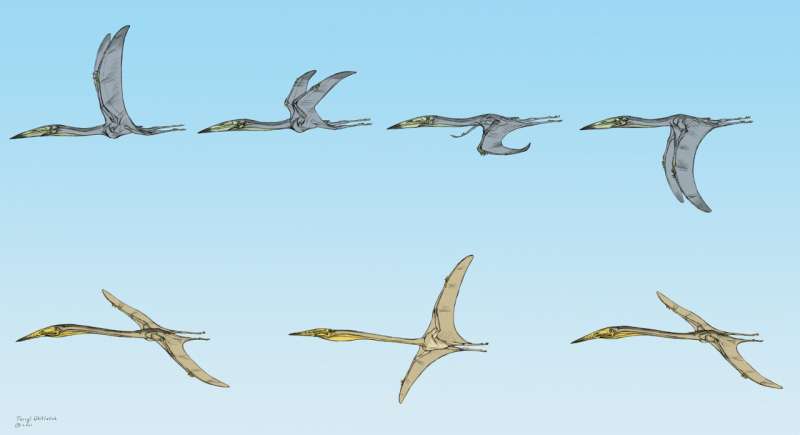This article has been reviewed according to Science X's editorial process and policies. Editors have highlighted the following attributes while ensuring the content's credibility:
fact-checked
peer-reviewed publication
trusted source
proofread
'Some pterosaurs would flap, others would soar'—new study confirms flight capability of these giants of the skies

Some species of pterosaurs flew by flapping their wings while others soared like vultures, demonstrates a new study published in the Journal of Vertebrate Paleontology.
It has long been debated whether the largest pterosaurs could fly at all.
However, "remarkable" and "rare" three-dimensional fossils of two different large-bodied azhdarchoid pterosaur species—including one new to science—have enabled scientists to hypothesize that not only could the largest pterosaurs take to the air, but their flight styles could differ too.
The new findings are led by experts from the University of Michigan, in the US; the Natural Resources Authority and Yarmouk University, in Jordan; and the Saudi Geological Survey, in Saudi Arabia.
Their paper details how these fossils—which date back to the latest Cretaceous period (approximately 72 to 66 million years ago)—were remarkably three-dimensionally preserved within the two different sites that preserve a nearshore environment on the margin of Afro-Arabia, an ancient landmass that included both Africa and the Arabian Peninsula.
The research team used high-resolution computed tomography (CT) scans to then analyze the internal structure of the wing bones.
"The dig team was extremely surprised to find three-dimensionally preserved pterosaur bones. This is a very rare occurrence," explains lead author Dr. Kierstin Rosenbach, from the Department of Earth and Environmental Sciences of the University of Michigan.
"Since pterosaur bones are hollow, they are very fragile and are more likely to be found flattened like a pancake, if they are preserved at all.
"With 3D preservation being so rare, we do not have a lot of information about what pterosaur bones look like on the inside, so I wanted to CT scan them.
"It was entirely possible that nothing was preserved inside, or that CT scanners were not sensitive enough to differentiate fossil bone tissue from the surrounding matrix."
Luckily, though, what the team uncovered was "remarkable," via "exciting internal structures not only preserved, but visible in the CT scanner."

CT scans reveal one soars, one flaps
Newly collected specimens of the already-known giant pterosaur, Arambourgiania philadelphiae, confirm its 10-meter wingspan and provide the first details of its bone structure. CT images revealed that the interior of its humerus, which is hollow, contains a series of ridges that spiral up and down the bone.
This resembles structures in the interior of wing bones of vultures. The spiral ridges are hypothesized to resist the torsional loadings associated with soaring (sustained powered flight that requires launch and maintenance flapping).
The other specimen analyzed was the new-to-science Inabtanin alarabia, which had a five-meter wingspan. The team named it after the place where it was excavated—near a large grape-colored hill, called Tal Inab. The generic name combines the Arabic words "inab," for grape, and "tanin" for dragon. "Alarabia" refers to the Arabian Peninsula.
Inabtanin is one of the most complete pterosaurs ever recovered from Afro-Arabia, and the CT scans revealed the structure of its flight bones was completely different from that of Arambourgiania.

The interior of the flight bones were crisscrossed by an arrangement with struts that match those found in the wing bones of modern flapping birds.
This indicates it was adapted to resist bending loads associated with flapping flight, and so it is likely that Inabtanin flew this way—although this does not preclude occasional use of other flight styles too.
"The struts found in Inabtanin were cool to see, though not unusual," says Dr. Rosenbach. "The ridges in Arambourgiania were completely unexpected, we weren't sure what we were seeing at first. Being able to see the full 3D model of Arambourgiania's humerus lined with helical ridges was just so exciting."
What explains this difference?
The discovery of diverse flight styles in differently-sized pterosaurs is "exciting," the experts state, because it opens a window into how these animals lived. It also poses interesting questions, like to what extent flight style is correlated with body size and which flight style is more common among pterosaurs.

"There is such limited information on the internal bone structure of pterosaurs across time, it is difficult to say with certainty which flight style came first," Dr. Rosenbach adds. "If we look to other flying vertebrate groups, birds and bats, we can see that flapping is by far the most common flight behavior. Even birds that soar or glide require some flapping to get in the air and maintain flight.
"This leads me to believe that flapping flight is the default condition, and that the behavior of soaring would perhaps evolve later if it were advantageous for the pterosaur population in a specific environment; in this case the open ocean."
Co-author Professor Jeff Wilson Mantilla, Curator at Michigan's Museum of Paleontology, and Dr. Iyad Zalmout, from the Saudi Geological Survey, found these specimens in 2007 at sites in the north and south of Jordan.
Professor Jeff Wilson Mantilla says the "variations likely reflect responses to mechanical forces applied on the pterosaurs' wings during flight."
Enabling further study of vertebrate flight
Concluding, Dr. Rosenbach states, "Pterosaurs were the earliest and largest vertebrates to evolve powered flight, but they are the only major volant group that has gone extinct. Attempts to-date to understand their flight mechanics have relied on aerodynamic principles and analogy with extant birds and bats.
"This study provides a framework for further investigation of the correlation between internal bone structure and flight capacity and behavior, and will hopefully lead to broader sampling of flight bone structure in pterosaur specimens."
More information: New pterosaur remains from the Late Cretaceous of Afro-Arabia provide insight into flight capacity of large pterosaurs, Journal of Vertebrate Paleontology (2024). DOI: 10.1080/02724634.2024.2385068. www.tandfonline.com/doi/full/1 … 2724634.2024.2385068
Journal information: Journal of Vertebrate Paleontology
Provided by Taylor & Francis





















